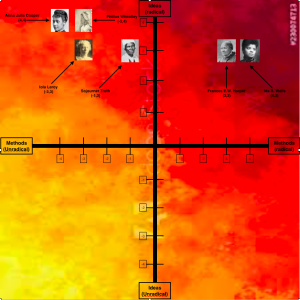What is Radical?
Being seen as blatantly fighting against the system and structures imposed by white systemic oppression.
So then what’s Unradical?
Using methods that seem to fight within the system already imposed. Using “proper language” (white men’s standard)
-
-
-
- However, this can be seen as infiltrating the system to change it.
-
-
Radical Scale

How to Interpret the Scale
The Radical vs. Unradical graph is meant to be a helpful visualization to understand how each of the unique women we’ve studied relates to one another. We found examining methods and ideology to be the most helpful in showcasing the different kinds of contributions of each woman, but we want to highlight that each women is not reduced to such neat categories as “methods” and “ideas”. The more complicated stories of their lives can be found on their pages. The top right quadrant of this graph includes women with both radical methodology and radical ideas, namely Frances E.W. Harper and Ida B. Wells. Their placement in this quadrant together does not mean they were the same; each had unique contexts and challenges, and while the graph highlights that they were both similarly radical their pages explain that statement. The top-left quadrant of the graph includes Phillis Wheatley, Sojourner Truth, Iola Leroy, and Anna Julia Cooper. These women, by varying degrees, held radical views and expressed them using unradical means. How they relate to each other can help us understand why some reached fame (Sojourner Truth) while others lived reclusively (A.J. Cooper) but, just as with the top-right quadrant, their stories don’t end there.
Carving Out Space
Intersectionality is a sometimes slippery definition, a word too small to define the placelessness of Black American women. Each person we’ve studied in this class has carved a new space for Black women, from Phillis Wheatley’s groundbreaking poetry and learnedness or Ida. B. Well’s laconic exposes. What bounds all of the women on the graph together is their shared struggle to carve a space for themselves and their shared fight to grow the space available for Black women in America. This shared goal was accomplished because each women was so unique, and our graph can be seen as a visualization of that ever widening space available for those who are both black and female and their diversity of thought and opinion within the Black community. Within their carved spaces each had their own views and were motivated uniquely to make art and express themselves.
This semester we focused a lot on the value of out-loud activism in this class. While ideas like “intersectionality” and “identity” seem too broad to encapsulate what it means to be a Black woman in the United States at any given time, Frances E.W. Harper’s “Songs For the People” does a better job. The poem sings, peaceful and measured, as much art as it is a radical statement of how Harper remakes the world into a place she fits. Listen below: